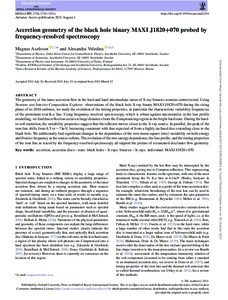Accretion geometry of the black hole binary MAXI J1820+070 probed by frequency-resolved spectroscopy
Veledina Alexandra; Axelsson Magnus
https://urn.fi/URN:NBN:fi-fe2021102752682
Tiivistelmä
The geometry of the inner accretion flow in the hard and hard-intermediate states of X-ray binaries remains controversial. Using Neutron star Interior Composition Explorer observations of the black hole X-ray binary MAXI J1820+070 during the rising phase of its 2018 outburst, we study the evolution of the timing properties, in particular the characteristic variability frequencies of the prominent iron K α line. Using frequency-resolved spectroscopy, which is robust against uncertainties in the line profile modelling, we find that reflection occurs at large distances from the Comptonizing region in the bright hard state. During the hard-to-soft transition, the variability properties suggest that the reflector moves closer to the X-ray source. In parallel, the peak of the iron line shifts from 6.5 to ~7 keV, becoming consistent with that expected of from a highly inclined disc extending close to the black hole. We additionally find significant changes in the dependence of the root-mean-square (rms) variability on both energy and Fourier frequency as the source softens. The evolution of the rms-energy dependence, the line profile, and the timing properties of the iron line as traced by the frequency-resolved spectroscopy all support the picture of a truncated disc/inner flow geometry.
Kokoelmat
- Rinnakkaistallenteet [19207]
